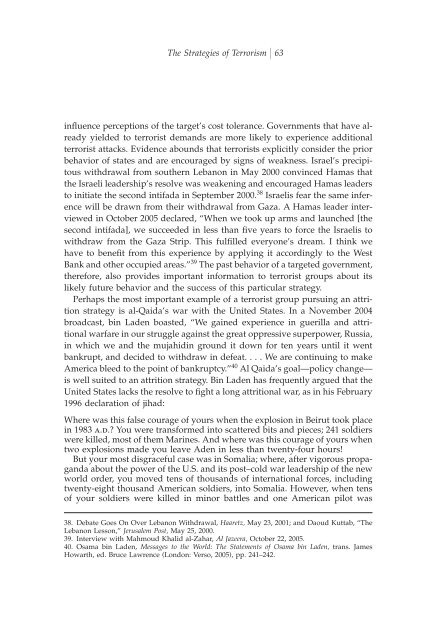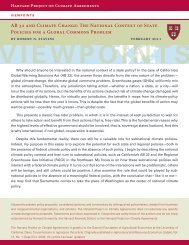The Strategies of Terrorism - MIT Press Journals
The Strategies of Terrorism - MIT Press Journals
The Strategies of Terrorism - MIT Press Journals
You also want an ePaper? Increase the reach of your titles
YUMPU automatically turns print PDFs into web optimized ePapers that Google loves.
<strong>The</strong> <strong>Strategies</strong> <strong>of</strong> <strong>Terrorism</strong> 63inºuence perceptions <strong>of</strong> the target’s cost tolerance. Governments that have alreadyyielded to terrorist demands are more likely to experience additionalterrorist attacks. Evidence abounds that terrorists explicitly consider the priorbehavior <strong>of</strong> states and are encouraged by signs <strong>of</strong> weakness. Israel’s precipitouswithdrawal from southern Lebanon in May 2000 convinced Hamas thatthe Israeli leadership’s resolve was weakening and encouraged Hamas leadersto initiate the second intifada in September 2000. 38 Israelis fear the same inferencewill be drawn from their withdrawal from Gaza. A Hamas leader interviewedin October 2005 declared, “When we took up arms and launched [thesecond intifada], we succeeded in less than ªve years to force the Israelis towithdraw from the Gaza Strip. This fulªlled everyone’s dream. I think wehave to beneªt from this experience by applying it accordingly to the WestBank and other occupied areas.” 39 <strong>The</strong> past behavior <strong>of</strong> a targeted government,therefore, also provides important information to terrorist groups about itslikely future behavior and the success <strong>of</strong> this particular strategy.Perhaps the most important example <strong>of</strong> a terrorist group pursuing an attritionstrategy is al-Qaida’s war with the United States. In a November 2004broadcast, bin Laden boasted, “We gained experience in guerilla and attritionalwarfare in our struggle against the great oppressive superpower, Russia,in which we and the mujahidin ground it down for ten years until it wentbankrupt, and decided to withdraw in defeat. ...Wearecontinuing to makeAmerica bleed to the point <strong>of</strong> bankruptcy.” 40 Al Qaida’s goal—policy change—is well suited to an attrition strategy. Bin Laden has frequently argued that theUnited States lacks the resolve to ªght a long attritional war, as in his February1996 declaration <strong>of</strong> jihad:Where was this false courage <strong>of</strong> yours when the explosion in Beirut took placein 1983 a.d.? You were transformed into scattered bits and pieces; 241 soldierswere killed, most <strong>of</strong> them Marines. And where was this courage <strong>of</strong> yours whentwo explosions made you leave Aden in less than twenty-four hours!But your most disgraceful case was in Somalia; where, after vigorous propagandaabout the power <strong>of</strong> the U.S. and its post–cold war leadership <strong>of</strong> the newworld order, you moved tens <strong>of</strong> thousands <strong>of</strong> international forces, includingtwenty-eight thousand American soldiers, into Somalia. However, when tens<strong>of</strong> your soldiers were killed in minor battles and one American pilot was38. Debate Goes On Over Lebanon Withdrawal, Haaretz, May 23, 2001; and Daoud Kuttab, “<strong>The</strong>Lebanon Lesson,” Jerusalem Post, May 25, 2000.39. Interview with Mahmoud Khalid al-Zahar, Al Jazeera, October 22, 2005.40. Osama bin Laden, Messages to the World: <strong>The</strong> Statements <strong>of</strong> Osama bin Laden, trans. JamesHowarth, ed. Bruce Lawrence (London: Verso, 2005), pp. 241–242.














